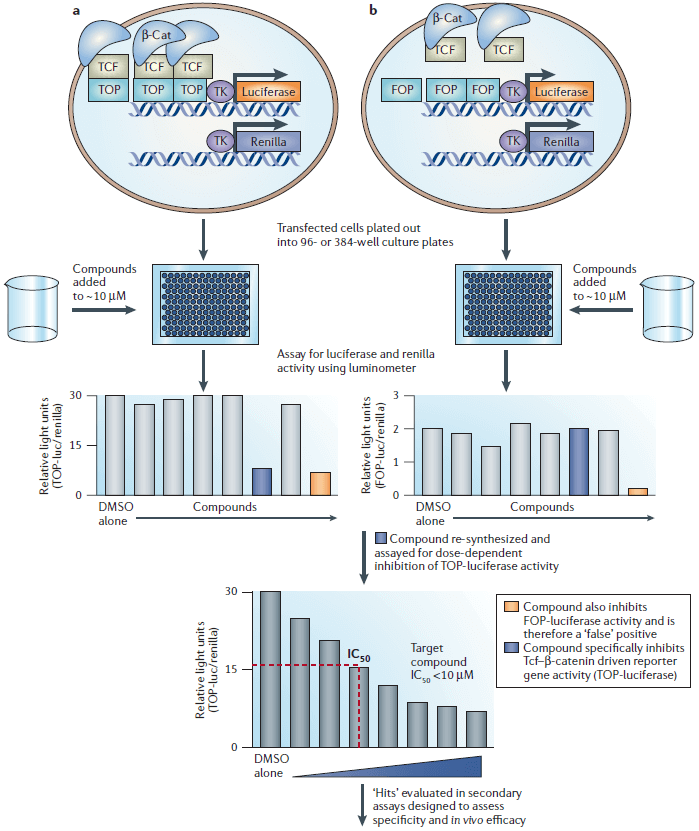Luciferase Reporter Assays
Creative Bioarray provides high-quality luciferase reporter assays to assist your fundamental research and drug discovery. You will benefit from our expertise, state-of-the-art platform and high efficiency.
Introduction of Luciferase Reporter Assays
Bioluminescence is the production and emission of light through chemical reactions by living organisms in their bodies. It occurs widely in various organisms, such as some marine vertebrates, invertebrates, terrestrial arthropod, microorganismsa and fungi. Generally speaking, the principle chemical reaction of bioluminescence is the oxidation of the luciferin substrate catalyzed by luciferase. Firefly luciferase is the most widely used natural luceferase for biological and medical purposes.
 Figure 1. Chemical reaction catalyzed by firefly luciferase. (Fan F, & Wood K V., 2007)
Figure 1. Chemical reaction catalyzed by firefly luciferase. (Fan F, & Wood K V., 2007)
The reaction of luciferase reporter assay generally involves the oxidative decarboxylation of luciferase substrate in the presence of O2 to yield photon emission which can be sensitively detected. Because of the variation in bioluminescence output by different luciferases from different species or produced in labs through genetic engineering, they can be used to for different experimental purposes.

Figure 2. A cell-based assay for screening compound libraries for small-molecule inhibitors of the Wnt pathway. (Barker N, & Clevers H, 2016)
Applications of Luciferase Reporter Assays
Luciferase reporter assays have been widely used in cell biology, molecular biology and pharmaceutical industries.
- Used to study gene expression, regulation and function at the transcriptional and translational level.
- Used to study the structure and function of promoters.
- Used to study cellular components and events, for example, to evaluate cell viability by detecting ATP, or to quantify cell signaling pathways.
- Used to study protein stability, protein interactions and posttranslational modifications.
- Used for high-throughput screening and analyses of compounds, such as agonists, antagonists and allosteric modulators.
- Used for target identification and engagement in drug discovery.
- Used to generate live-cell biosensors for bioluminescence imaging.
Advantages of Luciferase Reporter Assays
- Extreme sensitivity makes it possible to quantify small changes in transcription.
- The availability of results within minutes.
- Unparalleled dynamic range and versatility.
- Genetic engineering can be carried out for different purposes.
- Easy to use and relatively inexpensive.
- Virtually background-free with a high signal-to-background ratio.
Luciferase Reporter Assays Available at Creative Bioarray
Luciferase from different organisms, such as Firefly Luciferase, Cypridina Luciferase, Renilla Luciferase, Turbo Luciferase and Gaussia Luciferase, are available at Creative Bioarray. For different research target of interest, we can develop the most appropriate solution based on the following assays.
Single Luciferase Reporter Assays
Luciferase reporter assays can be used as single analysis for the measurement of single luciferase activity. This method, which is highly sensitive with a broader linear response range, is suitable for high throughput screening.
Dual-Luciferase Reporter Assays
Luciferase reporter assays can also be used as dual assays for the detection of two luciferases per sample. The activities of two luciferases are measured sequentially depending upon their substrates. This method allows for data normalization and improves data reliability.
Multicolor Luciferase Reporter Assays
Multicolor luciferase reporter assays make it possible to simultaneously monitor the sequential and complex changes in the expression of several genes. This method can be used for large-scale data interpretation from the single-cell level to the tissue level.
Secreted Luciferase Reporter Assays
The secreted luciferase has the characteristics of high sensitivity, easy to detect, and real-time monitoring of living cells or organisms. Secreted luciferase reporter assay can be used for detailed analysis of promoter and transcriptomes, screening new drugs or detecting harmful chemicals.
Real-Time Luciferase Reporter Assays
Real-time luciferase reporter assay is an attractive tool that can be simultaneously used upon many different experimental conditions. This method has the advantages of quick detection, accurate measurement of kinetic parameters, and real-time quantification.
Imaging Luciferase Reporter Assays
Imaging using luciferase reporters is one of the simplest, sensitive and cost-effective methods among known optical imaging techniques. This method is a powerful tool to image a large number of samples, from single molecules to whole organisms.
Creative Bioarray has the capacity to tailor the best solution according to your specific purpose. Our services have the advantages of fast turnaround time and competitive price. If you need more detailed information, please feel free to contact us. We look forward to cooperating with you.
References:
- Fan F, & Wood K V. Bioluminescent assays for high-throughput screening. Assay and drug development technologies, 2007, 5(1), pp: 127-136.
- Barker N, & Clevers H. Mining the Wnt pathway for cancer therapeutics. Nature reviews Drug discovery, 2006, 5(12), pp: 997-1014.
- Greer III L F, & Szalay A A. Imaging of light emission from the expression of luciferases in living cells and organisms: a review. Luminescence: the journal of biological and chemical luminescence, 2002, 17(1), pp: 43-74.
For research use only. Not for any other purpose.

 Figure 1. Chemical reaction catalyzed by firefly luciferase. (Fan F, & Wood K V., 2007)
Figure 1. Chemical reaction catalyzed by firefly luciferase. (Fan F, & Wood K V., 2007) 
